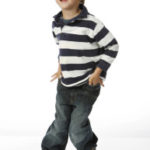An Austrian study exploring the role of genu valgum and flatfoot in obese and normal weight children found obesity was associated with higher peak plantar pressures, but lower maximum force while walking, when forces were normalized to body weight.
The findings suggest compensation may occur in gait and that dynamic measures may be more clinically important than static views.
Lead author Robert Bernecker, MS, and his team at the University Clinic for Physical Medicine & Rehabilitation in Salzburg, Austria, analyzed 34 children, 13 of whom were obese (mean body mass index of 31.2) and had genu valgum and/or flatfoot. Using a force platform system, the researchers assessed contact area, maximum force, and peak pressure during 10-second single-leg stands and during gait; they also assessed contact time during gait.
For the static condition, obesity was associated with significantly greater contact area. During gait, obesity was associated with significantly higher peak pressures and greater contact time for all areas of the foot except the toes, but lower normalized maximum force in the hind foot and the big toe. The findings were presented in August at the Expert Scientific Meeting, held in Aalborg, Denmark.
The lower normalized dynamic forces in the heavier children may indicate some type of compensatory gait adaptation. However, a slower gait in the obese children than in the normal-weight children may also have contributed to the findings, Bernecker said.
Bernecker believes a future study comparing a different static measure to traditional dynamic assessment is needed to elucidate his preliminary conclusions.
“The maximum peak force, not normalized, is a more widely used parameter in scientific literature, and this parameter was significantly higher in our findings compared with those found in the extensive research by Dowling and Mickle,” he said.
“It would be interesting to find out about their maximum forces normalized to body weight.”
Sarah Shultz, PhD, ATC, a lecturer in exercise and sport science at Massey University in Wellington, New Zealand, and lead researcher of orthopedic complications of childhood obesity, highlighted the Austrian findings of increased contact area during standing and increased plantar pressures during gait in the obese children.
“What is remarkable is that the obese children are displaying larger contact area during static standing [which is often seen as a mechanism for maintaining balance] and still showing greater peak pressures during walking,” she said.
Shultz’s concern is that surface areas of children’s bones do not grow proportionately to their weight.
“Bones and joints that are absorbing the impact of these forces are not any larger than those in a child who does not carry extra mass,” she said.
Injuries that may occur as a result of increased force when obese children compensate or modify their gait include stress fractures and plantar fasciitis, Shultz said.
“There are also possible implications farther up the lower extremity kinetic chain, which is already evident in the obese children in the Bernecker study who display genu valgum,” she said.
The genu valgum, in fact, may be a more critical risk factor for future pathology than flatfoot, Bernecker said.
“Orthopedically, the first concern is the valgus misalignment, not the foot,” Bernecker stressed.
He anticipates future studies that identify the age of obesity onset might better indicate the point at which it leads to genu valgum.
“Moreover, it would be a great idea to compare obese children with different characteristics concerning genu valgum and flatfoot,” he added.
Michele M. Zembo, MD, MBA, assistant dean for clinical education at Tulane University School of Medicine in New Orleans, has treated many overweight children in more than 25 years of practicing pediatric orthopedic surgery.
Dynamic studies, including gait analysis, are an essential component of evidence-based clinical decisions that also depend on experience and observation, Zembo said, but there is also a role for static measures.
“The majority of foot problems in obese children that families worry are deformities are actually caused by poor-fitting shoes,” she said. “In such cases, a static footprint placed on the upturned shoe sole is essential for explaining what is happening to the child’s foot inside that shoe every day.”
Christina Hall Nettles is a freelance writer based in Monroeville, AL.
Sources:
Bernecker R, Weghuber D, Landauer F, et al. Does genu valgum and/or flatfoot play a role in dynamic plantar pressures and static footprints in obese and non obese children? Presented at the 13th Expert Scientific Meeting, Aalborg, Denmark, August 2012.
Dowling AM, Steele JR, Baur LA. What are the effects of obesity in children on plantar pressure distributions? Int J Obes Relat Metab Disord 2004; 28(11):1514-1519.
Mickle KJ, Steele JR, Munro BJ. Does excess mass affect plantar pressure in young children? Int J Pediatr Obes 2006;1(3):183-188.






